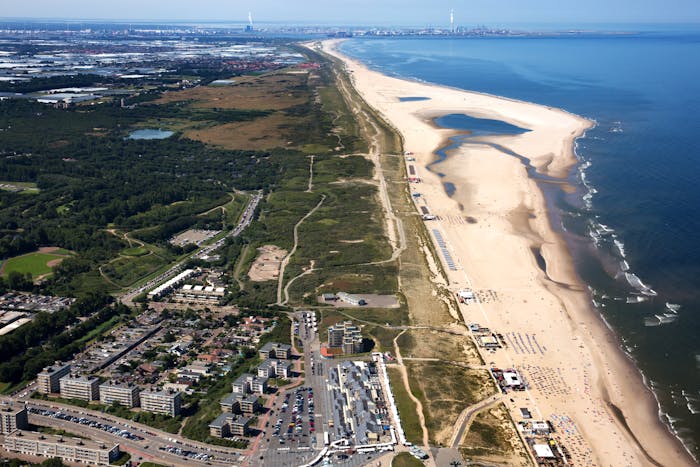Nature Attacks the Coast in the Netherlands
The Dutch coast is constantly under attack by the sea.
If dunes, dykes and water barriers were not maintained, the sea would reclaim many meters of land at some places along the coast every year. This is why the Dutch have long been famous for their battle against water. The threat from the sea is neutralised by sand replenishments. Near the city of The Hague such sand replenishments usually take place every three to five years. This sand is dredged from the bottom of the North Sea. As a result, plants and small organisms in some places along the coast are buried under mountains of sand every five years. The extraction of sand also disturbs the balance of life in the sea.
"In 2011, one of the largest sientific experiments in coastal protection took shape in the Netherlands; the sandmotor. [Music] {The Sand Motor- Five years of building with nature} An aritifical peninsula designed to nourish the Delft land coast for the coming 20 years." The sand motor slowly spreads towards the beaches and dunes under the influence of waves, tides and wind. Here nature does its job. Different plants, birds and other animals emerge while nature lovers explore the fascinating and unique coastal landscape of the sandmotor. To plan the realization of the sand motor, financial resources, knowledge, skills and cooperation of all parties involved was essential. For such a large project, it was quite a challenge to get everyone on the same page. Three goals were defined. Contributing to coastal safety, adding an attractive area for leisure activities and nature development and stimulate knowledge development about coastal management. "At the start of this ambitious project, there were only calculated assumptions about what was going to happen in the next couple of years. There were lots of challenges and numerous questions. [Music]" "[Music] {How fast will the sand spread?} {Will it attract more fish and birds?} {Will the changed currents affect swimmer safety?}" "{How will the visitors use the new landscape?} Right after its completion the sand motor was still a largely empty penninsula of sand. Ready for nature to spread its sand to the beaches" To carefully monitor this process a large team of scientists from knowledge institutes, universities, the government and engineering firms joined forces. They monitored the development of the beach and the seabed, the currents, the dunes, groundwater levels, flora and fauna. As well as swimmers safety, the administrative implications and the value for leisure activities. [Music] Five years after construction, the time has come for first conclusions. There are some exciting results that contribute to the knowledge about coastal management. So far, the sandmotor has done its job when it comes to spreading sand along the coast. Calculations show that the sandmotor could work much longer than the 20 years that were originally expected. The wind and currents spread the sand mainly in a northeasterly direction onto the beach and into the dunes. A lagoon formed along the beach and sometimes cliffs appeared at the north side. Overtime, the lagoon became longer and shallower. In 2016, a new channel was formed as a result of a passing storm. "[Music] {Dune development} Data show that the dune growth in the first five years went slower than expected. This is mainly because the sand has to travel a long way to the dunes." On its path the sand first comesacross the lagoon and the dune lake. Once these are fille dup more, sand will be liekly to find its way to the dunes faster. Fortunately, dunes developed well on the previously built coastal reinforcements "Characteristic types of beach grass have settled on the sandmotoer. Also, sea holly found its home, a protected plant species. [Music]" "At this time its not yet possible to give an answer to whether the sandmotor is better for sea bed life than traditional coastal nourishments. Therefore, a longer period of research is needed. [Music]" "So far the researchers encountered small animals such as the Baltic clam and the sand to worm in the lagoon. These species are not often found in the Norther and South Holland coast. [Music]" The new coastline creates new kinds of currents, therefore swimmer safety is carefully monitored. Rescue services are very satisfied with a newly developed app which could also be tailored for other beaches in the world. Leisure activities on and along the beaches near the sandmotor have increased. Research shows that visitors appreciate this new landscape because of its space and quietness. Five years, in this time we have learned a lot about building with nature. But we still have many years to go. Years in which we expect to gain more knowledge about this ambitious project. Knowledge that contributes to the imporvement of the future coastal management plans and alternative beach nourishment. [Music] Research shows that the sandmotor concept is applicable in several places along the Dutch coast as well as in the rest of the world. One of the first concrete follow-ups are the plans for a sandmotor in Norfold, northeast of London. All the efforts in creating and researching the sandmotor have proven very rewarding so far. {With special thanks to Shore Monitoring 2016 A production of Van Viler Media}
Created in partnership with:
![]() Deltares
Deltares

 13 Climate Action
13 Climate Action
 11 Sustainable Cities and Communities
11 Sustainable Cities and Communities